Scottish Household Survey 2020 - telephone survey: culture and heritage report
Reports on culture and heritage data from the Scottish Household Survey 2020: telephone survey.
4. Attendance at Cultural Events and Places
Cultural attendance is captured in the SHS by asking respondents if they have attended specific events or places from the available list asked of respondents in the survey at least once in the last 12 months.
In previous years, results for cultural attendance have been presented both including and excluding visits to the cinema, to help illustrate different facets of cultural attendance. To maintain consistency with presentation of the data in previous years' reports, cultural attendance is reported with cinema visits both included and excluded in this report.
In 2020, 44 per cent of adults in Scotland had attended or visited a cultural event or place in the last 12 months. When trips to the cinema are excluded, the attendance figure was lower at 39 per cent.
Figure 4.1 shows that the most common places that adults attended were historic places (18 per cent) and the cinema (17 per cent). There was a lower share of adults that visited the library (13 per cent), museums (12 per cent) and art galleries and theatres (8 per cent).
56 per cent of adults had not attended a cultural event or visited a place of culture in the last 12 months. This may in part reflect the impact of Covid-19 on opportunities for attending different cultural and heritage settings during 2020.
Percentage of adults, 2020 data (base: 2,790)
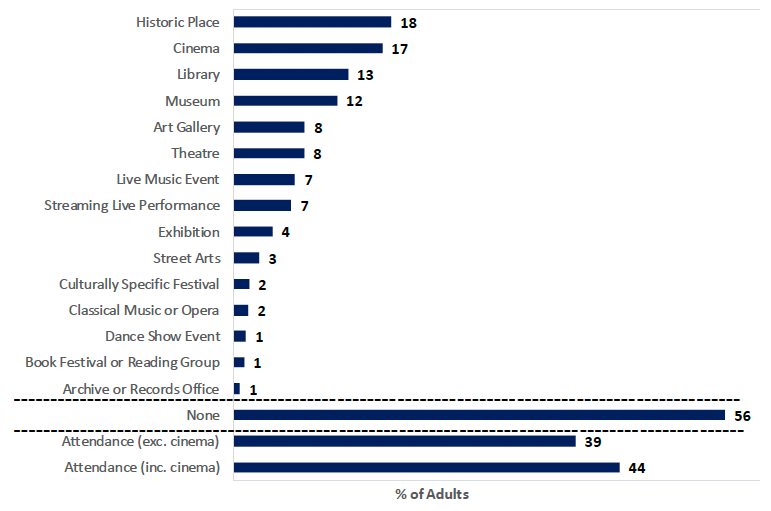
4.1 Frequency of Attendance
In 2020, 9 per cent of adults who go to the library did so at least once per week and 19 per cent went at least once a month (Table 4.1).
In 2020, a new response was added to allow respondents to indicate that they do not go nowadays due to Covid. 16 per cent of adults reported that they did not go to an art gallery due to Covid and 13 per cent of adults said the same for going to museums and classical music or opera events.
Percentage of adults, 2020 data
| Adults | At least once a week |
At least once a month |
At least once a year |
Don't go nowadays due to Covid |
Don't know |
Base |
|---|---|---|---|---|---|---|
| Cinema | 3 | 4 | 80 | 12 | 1 | 440 |
| Library | 9 | 19 | 61 | 10 | 2 | 400 |
| Classical Music or Opera | 0 | 7 | 73 | 13 | 6 | 70 |
| Live Music Event | 2 | 4 | 81 | 11 | 1 | 210 |
| Theatre | 2 | 3 | 81 | 12 | 2 | 210 |
| Dance Show Event | [u] | [u] | [u] | [u] | [u] | 50 |
| Historic Place | 2 | 10 | 79 | 8 | 1 | 480 |
| Museum | 1 | 4 | 79 | 13 | 2 | 330 |
| Art Gallery | 1 | 3 | 79 | 16 | 2 | 250 |
| Exhibition | 0 | 4 | 83 | 10 | 3 | 140 |
| Street Arts | 0 | 9 | 74 | 12 | 5 | 70 |
| Culturally Specific Festival | [u] | [u] | [u] | [u] | [u] | 50 |
| Book Festival or Reading Group | [u] | [u] | [u] | [u] | [u] | 40 |
| Archive or Records Office | [u] | [u] | [u] | [u] | [u] | 20 |
| Streaming Live Performance | 4 | 8 | 75 | 10 | 3 | 180 |
Note:
1) [u] = suppressed value. This is where the base is less than 50 and such data are judged to be insufficiently reliable for publication.
2) Estimates with base numbers close to 50 should also be treated with caution, as even though these estimates have been published, they are subject to high levels of sampling error and have a high degree of uncertainty around them.
4.2 Attendance by Gender
In 2020, attendance at a cultural event or place in the last 12 months was similar between women and men. 45 per cent of women had attended or visited a cultural event or place compared to 43 per cent of men (Figure 4.2). After excluding trips to the cinema, 40 per cent of women attended or visited a cultural event or place compared to 39 per cent of men.
Percentage of adults, 2020 data (minimum base: 1,250 [Men])
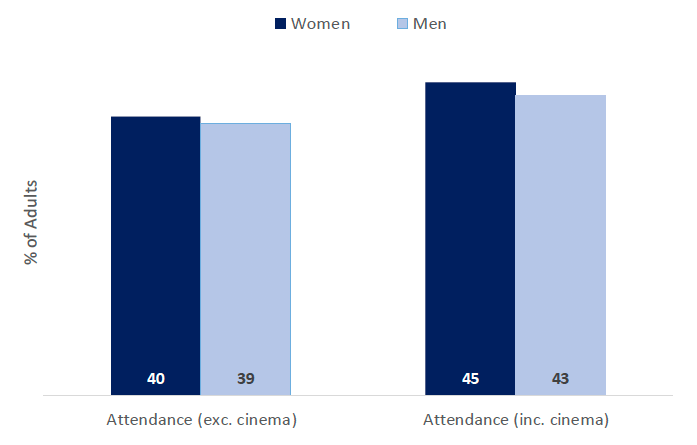
Table 4.2 shows that gender differences in attendance were observed for particular cultural events and places. More men than women visited a historic place (21 per cent compared with 15 per cent). However, women were more likely than men to attend the theatre (9 per cent compared with 6 per cent) or stream a live performance (8 per cent compared with 5 per cent). However, attendance was broadly similar across the majority of places or events (cinema, art galleries, street arts, for example).
Percentage of adults, 2020 data
| Adults | Women | Men | All |
|---|---|---|---|
| Cinema | 17 | 17 | 17 |
| Library | 14 | 13 | 13 |
| Classical Music or Opera | 2 | 1 | 2 |
| Live Music Event | 7 | 8 | 7 |
| Theatre | 9 | 6 | 8 |
| Dance Show Event | 2 | 1 | 1 |
| Historic Place | 15 | 21 | 18 |
| Museum | 11 | 12 | 12 |
| Art Gallery | 8 | 8 | 8 |
| Exhibition | 4 | 4 | 4 |
| Street Arts | 3 | 3 | 3 |
| Culturally Specific Festival | 2 | 2 | 2 |
| Book Festival or Reading Group | 1 | 0 | 1 |
| Archive or Records Office | 0 | 1 | 1 |
| Streaming Live Performance | 8 | 5 | 7 |
| None | 55 | 57 | 56 |
| Attendance (exc. cinema) | 40 | 39 | 39 |
| Attendance (inc. cinema) | 45 | 43 | 44 |
| Base | 1,530 | 1,250 | 2,790 |
Note:
1) Columns may not add to 100 per cent since multiple responses were allowed.
2) 'Gender described in another way' and 'Refused' not included in table as all estimates for this sub-group are suppressed because of the small sample size.
4.3 Attendance by Age
In 2020, notably higher portions of younger age groups attended cultural events or visited places of culture in the last 12 months than older age groups. A higher share of 16 to 24 year olds (55 per cent) had attended or visited a cultural event or place compared to 23 per cent of those aged 75 and over (Figure 4.3). The pattern holds when cinema attendance is excluded (48 per cent and 21 per cent).
Percentage of adults, 2020 data (minimum base: 110 [16 to 24])
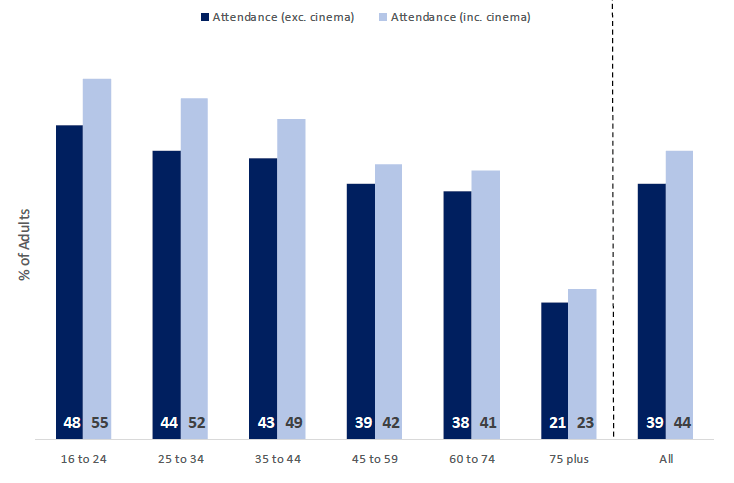
Table 4.3 shows that attendance at some cultural events or places, was lower for certain age groups. Compared to the average, adults aged over 75, were less likely to go to a historic place, the cinema, a museum, a live music event, a venue that streams live performances, the theatre, an art gallery or to watch streets arts.
Percentage of adults, 2020 data
| Adults | 16 to 24 | 25 to 34 | 35 to 44 | 45 to 59 | 60 to 74 | 75 plus | All |
|---|---|---|---|---|---|---|---|
| Cinema | 25 | 23 | 22 | 15 | 13 | 6 | 17 |
| Library | 10 | 16 | 18 | 12 | 13 | 12 | 13 |
| Classical Music or Opera | 0 | 2 | 1 | 2 | 2 | 1 | 2 |
| Live Music Event | 9 | 8 | 8 | 9 | 7 | 1 | 7 |
| Theatre | 12 | 7 | 6 | 8 | 8 | 4 | 8 |
| Dance Show Event | 0 | 1 | 2 | 2 | 2 | 0 | 1 |
| Historic Place | 17 | 20 | 23 | 20 | 15 | 6 | 18 |
| Museum | 10 | 15 | 15 | 13 | 11 | 5 | 12 |
| Art Gallery | 10 | 7 | 10 | 8 | 9 | 4 | 8 |
| Exhibition | 2 | 3 | 4 | 6 | 5 | 2 | 4 |
| Street Arts | 1 | 5 | 4 | 4 | 3 | 0 | 3 |
| Culturally Specific Festival | 1 | 2 | 3 | 1 | 2 | 0 | 2 |
| Book Festival or Reading Group | 1 | 1 | 1 | 1 | 1 | 1 | 1 |
| Archive or Records Office | 0 | 2 | 0 | 1 | 1 | 1 | 1 |
| Streaming Live Performance | 7 | 11 | 7 | 7 | 6 | 1 | 7 |
| None | 45 | 48 | 51 | 58 | 59 | 77 | 56 |
| Attendance (exc. cinema) | 48 | 44 | 43 | 39 | 38 | 21 | 39 |
| Attendance (inc. cinema) | 55 | 52 | 49 | 42 | 41 | 23 | 44 |
| Base | 110 | 250 | 310 | 720 | 1,010 | 400 | 2,790 |
Note:
1) Columns may not add to 100 per cent since multiple responses were allowed.
2) Estimates with base numbers close to 50 should also be treated with caution, as even though these estimates have been published, they are subject to high levels of sampling error and have a high degree of uncertainty around them.
4.4 Attendance by Highest Level of Qualification
In 2020, a higher portion of adults with degrees or professional qualifications (58 per cent) attended cultural events and visit places of culture than the Scottish population overall (44 per cent); attendance was lowest for those with no qualifications or 'other' qualifications (20 per cent) (Figure 4.4). The pattern holds when cinema attendance is excluded, 52 per cent compared to 17 per cent for adults with no qualifications and 16 per cent for adults with 'other' qualifications. In general, attendance declined with the level of qualifications.
Percentage of adults, 2020 data (minimum base: 100 [Other qualification])
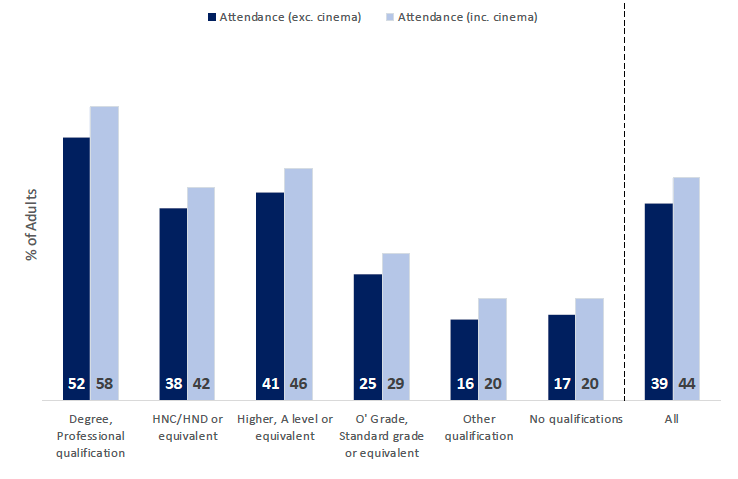
As with the overall figure, attendance across most individual events or places was generally highest for adults with a degree or professional qualification (Table 4.4). There were notable differences between those with a degree or professional qualification, and those with no qualifications, for the majority of individual events or places. The most marked differences between these groups can be seen for visits to a historic place (27 per cent and 7 per cent respectively), trips to the cinema (24 per cent and 5 percent respectively) and museum visits (20 per cent and 2 per cent respectively).
Percentage of adults, 2020 data
| Adults | Degree, Professional qualification | HNC/HND or equivalent | Higher, A level or equivalent | O' Grade, Standard grade or equivalent | Other qualification | No qualifications | All |
|---|---|---|---|---|---|---|---|
| Cinema | 24 | 15 | 18 | 11 | 10 | 5 | 17 |
| Library | 18 | 10 | 13 | 9 | 7 | 8 | 13 |
| Classical Music or Opera | 3 | 1 | 0 | 0 | 0 | 0 | 2 |
| Live Music Event | 9 | 8 | 8 | 5 | 5 | 3 | 7 |
| Theatre | 10 | 9 | 10 | 3 | 5 | 3 | 8 |
| Dance Show Event | 2 | 2 | 1 | 0 | 0 | 1 | 1 |
| Historic Place | 27 | 16 | 15 | 8 | 5 | 7 | 18 |
| Museum | 20 | 11 | 10 | 2 | 7 | 2 | 12 |
| Art Gallery | 14 | 5 | 7 | 3 | 3 | 1 | 8 |
| Exhibition | 7 | 5 | 2 | 0 | 3 | 0 | 4 |
| Street Arts | 5 | 3 | 1 | 1 | 0 | 0 | 3 |
| Culturally Specific Festival | 3 | 1 | 1 | 1 | 1 | 0 | 2 |
| Book Festival or Reading Group | 2 | 1 | 1 | 0 | 0 | 0 | 1 |
| Archive or Records Office | 1 | 1 | 0 | 0 | 0 | 0 | 1 |
| Streaming Live Performance | 11 | 4 | 6 | 4 | 2 | 1 | 7 |
| None | 42 | 58 | 54 | 71 | 80 | 80 | 56 |
| Attendance (exc. cinema) | 52 | 38 | 41 | 25 | 16 | 17 | 39 |
| Attendance (inc. cinema) | 58 | 42 | 46 | 29 | 20 | 20 | 44 |
| Base | 1,170 | 330 | 420 | 370 | 100 | 380 | 2,790 |
Note:
1) Columns may not add to 100 per cent since multiple responses were allowed.
2) Estimates with base numbers close to 50 should also be treated with caution, as even though these estimates have been published, they are subject to high levels of sampling error and have a high degree of uncertainty around them.
3) 'Qualifications not known' have been excluded from this figure.
4.5 Attendance by Scottish Index of Multiple Deprivation (SIMD)
In 2020, rates of cultural attendance were highest among those living in the 'least deprived' SIMD quintile, as measured by the Scottish Index of Multiple Deprivation (SIMD 2020). Figure 4.5 shows there was a significant difference in cultural attendance (including cinema) between those living in the 20 per cent most and 20 per cent least deprived areas (36 per cent compared with 53 per cent). When cinema attendance is excluded, the difference was similar, with 31 per cent of those living in the most deprived areas and 48 per cent in the least deprived areas attending or visiting a cultural event or place.
Percentage of adults, 2020 data (minimum base: 340 [Most deprived area])
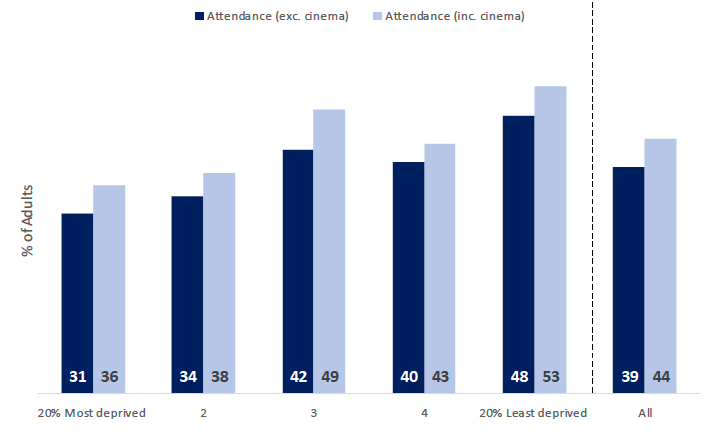
As with the overall figure, attendance at individual events or places was for the most part higher for adults living in the least deprived areas (Table 4.5). There were substantial differences between those living in the 20 per cent most and 20 per cent least deprived areas for most individual events or places. The most noticeable differences between those living in the most and least deprived areas can be seen for visits to historic places (12 per cent and 23 per cent respectively), art galleries (4 per cent and 13 per cent respectively), museums (7 per cent and 15 per cent respectively), and theatres (4 per cent and 12 per cent respectively). However, visits to libraries are similar between the most and least deprived areas (15 per cent and 16 per cent respectively).
Percentage of adults, 2020 data
| Adults | 20% Most deprived | 2 | 3 | 4 | 20% Least deprived | All |
|---|---|---|---|---|---|---|
| Cinema | 15 | 15 | 21 | 16 | 19 | 17 |
| Library | 15 | 11 | 15 | 11 | 16 | 13 |
| Classical Music or Opera | 1 | 1 | 1 | 2 | 3 | 2 |
| Live Music Event | 6 | 11 | 5 | 7 | 8 | 7 |
| Theatre | 4 | 9 | 8 | 6 | 12 | 8 |
| Dance Show Event | 1 | 0 | 1 | 1 | 2 | 1 |
| Historic Place | 12 | 13 | 17 | 20 | 23 | 18 |
| Museum | 7 | 10 | 12 | 14 | 15 | 12 |
| Art Gallery | 4 | 4 | 9 | 10 | 13 | 8 |
| Exhibition | 2 | 3 | 4 | 5 | 6 | 4 |
| Street Arts | 2 | 2 | 2 | 4 | 4 | 3 |
| Culturally Specific Festival | 2 | 2 | 2 | 1 | 2 | 2 |
| Book Festival or Reading Group | 1 | 1 | 1 | 0 | 1 | 1 |
| Archive or Records Office | 1 | 0 | 1 | 1 | 1 | 1 |
| Streaming Live Performance | 7 | 6 | 8 | 5 | 8 | 7 |
| None | 64 | 62 | 51 | 57 | 47 | 56 |
| Attendance (exc. cinema) | 31 | 34 | 42 | 40 | 48 | 39 |
| Attendance (inc. cinema) | 36 | 38 | 49 | 43 | 53 | 44 |
| Base | 340 | 430 | 660 | 750 | 620 | 2,790 |
Note:
1) Columns may not add to 100 per cent since multiple responses were allowed.
4.6 Attendance by Net Annual Household Income
In 2020, cultural attendance was generally higher among those with greater net annual household income. Half of those with a net annual household income of over £30,000 had attended or visited a cultural event or place in the last 12 months (Figure 4.6). Whereas, 29 per cent of respondents with a net annual household income of between £0 and £10,000 had attended or visited a cultural event or place. The pattern holds when cinema attendance is excluded (44 per cent compared to 26 per cent).
Percentage of adults, 2020 data (minimum base: 190 [£0 - £10,000])
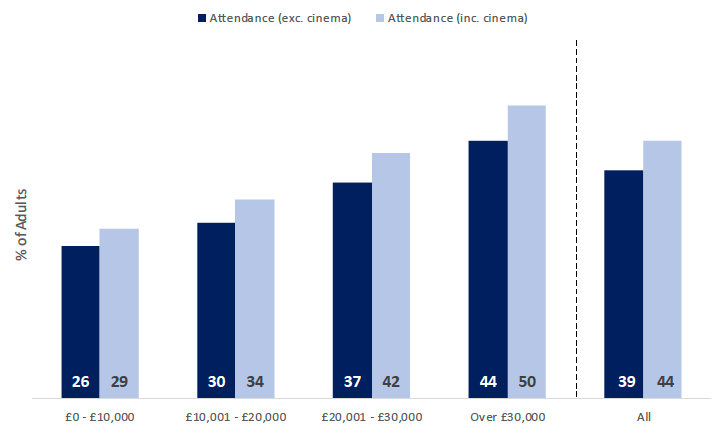
A larger share of those with a net annual household income of over £30,000 attended or visited certain individual cultural events and places than households with a net annual household income of less than £10,000 (Table 4.6). The biggest differences between those in these income groups can be seen for trips to historic places (22 per cent and 7 per cent respectively), visits to the cinema (21 per cent and 8 per cent respectively) and museum visits (13 per cent and 3 per cent respectively).
Percentage of adults, 2020 data
| Adults | £0 - £10,000 | £10,001 - £20,000 | £20,001 - £30,000 | Over £30,000 | All |
|---|---|---|---|---|---|
| Cinema | 8 | 10 | 16 | 21 | 17 |
| Library | 12 | 16 | 15 | 12 | 13 |
| Classical Music or Opera | 2 | 1 | 2 | 2 | 2 |
| Live Music Event | 5 | 4 | 6 | 9 | 7 |
| Theatre | 2 | 6 | 8 | 9 | 8 |
| Dance Show Event | 1 | 1 | 2 | 1 | 1 |
| Historic Place | 7 | 8 | 16 | 22 | 18 |
| Museum | 3 | 9 | 13 | 13 | 12 |
| Art Gallery | 2 | 5 | 10 | 9 | 8 |
| Exhibition | 1 | 2 | 5 | 5 | 4 |
| Street Arts | 4 | 0 | 5 | 3 | 3 |
| Culturally Specific Festival | 0 | 1 | 1 | 2 | 2 |
| Book Festival or Reading Group | 0 | 2 | 1 | 1 | 1 |
| Archive or Records Office | 0 | 0 | 1 | 1 | 1 |
| Streaming Live Performance | 4 | 3 | 6 | 9 | 7 |
| None | 71 | 66 | 58 | 50 | 56 |
| Attendance (exc. cinema) | 26 | 30 | 37 | 44 | 39 |
| Attendance (inc. cinema) | 29 | 34 | 42 | 50 | 44 |
| Base | 190 | 630 | 600 | 1,290 | 2,790 |
Note:
1) Columns may not add to 100 per cent since multiple responses were allowed.
2) Estimates with base numbers close to 50 should also be treated with caution, as even though these estimates have been published, they are subject to high levels of sampling error and have a high degree of uncertainty around them.
3) 'Unknown or low' incomes have been excluded from this table.
4.7 Attendance by Disability
In the SHS, 'disability' is defined as the presence of any physical or mental health condition or illness that is expected to last 12 months or more, and that reduces the person's ability to carry out day-to-day activities.[7]In 2020, cultural attendance was lower among adults that reported having such a condition. 32 per cent of those that reported a disability had attended or visited a cultural event or place compared with 48 per cent attendance for those that reported having no disability (Figure 4.7). When cinema is excluded, attendance for those with a disability was 28 per cent and for those with no disability, it was 43 per cent.
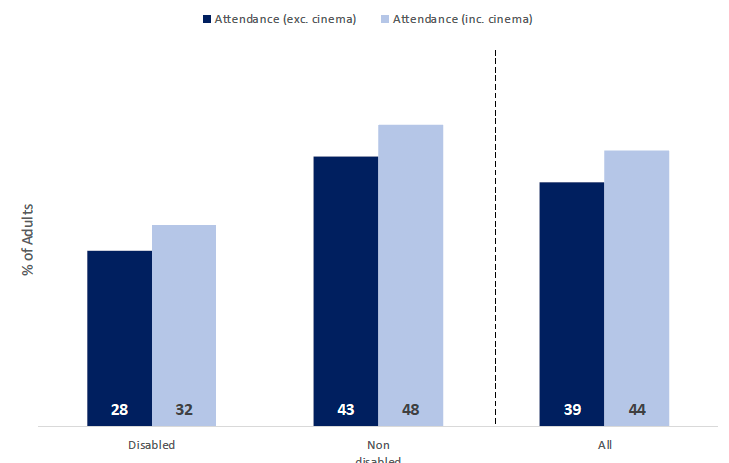
Percentage of adults, 2020 data (minimum base: 720 [disabled])
Attendance for around half the individual events or places were significantly higher for adults that did not report a disability (Table 4.7). The largest difference in attendance between these groups can be seen for trips to historic places (20 per cent and 9 per cent respectively). Other notable differences can be seen for visits to the cinema (19 per cent and 13 per cent respectively).
Percentage of adults, 2020 data
| Adults | Disabled | Non-disabled | All |
|---|---|---|---|
| Cinema | 13 | 19 | 17 |
| Library | 10 | 14 | 13 |
| Classical Music or Opera | 1 | 2 | 2 |
| Live Music Event | 7 | 8 | 7 |
| Theatre | 6 | 8 | 8 |
| Dance Show Event | 1 | 1 | 1 |
| Historic Place | 9 | 20 | 18 |
| Museum | 9 | 13 | 12 |
| Art Gallery | 5 | 9 | 8 |
| Exhibition | 2 | 5 | 4 |
| Street Arts | 1 | 4 | 3 |
| Culturally Specific Festival | 1 | 2 | 2 |
| Book Festival or Reading Group | 2 | 1 | 1 |
| Archive or Records Office | 1 | 1 | 1 |
| Streaming Live Performance | 5 | 7 | 7 |
| None | 68 | 52 | 56 |
| Attendance (exc. cinema) | 28 | 43 | 39 |
| Attendance (inc. cinema) | 32 | 48 | 44 |
| Base | 720 | 2,060 | 2,790 |
Note:
1) Columns may not add to 100 per cent since multiple responses were allowed.
2) A disability is defined in the SHS as a long-term limiting physical or mental health condition.
3) 'Don't Know' and 'Refused' responses have not been included in table as all estimates for this sub-group are suppressed because of the small sample size.
4.8 Attendance by Ethnicity
The SHS asked respondents to describe their ethnic background. These are coded based on each respondents' answer and are categorised in this report as either: 'White: Scottish', 'White: Other British', 'White: Other' or 'Minority Ethnic Groups'. The majority of respondents were 'White: Scottish' or 'White: Other British'. Therefore, to allow for a base sample that is judged to be sufficiently reliable for analysis, adults who answered 'Irish', 'Gypsy/Traveller', 'Polish' and 'other white ethnic groups' were grouped as 'White: Other' and adults that were 'Mixed or multiple', 'Asian', 'African', 'Caribbean or Black', 'Arab' or 'any other ethnic groups' were included in the 'Minority Ethnic Groups' category.
In 2020, cultural attendance (including cinema) was highest for 'White: Other' adults (65 per cent). 51 per cent of minority ethnic adults had attended or visited a cultural event or place compared with 42 per cent for 'White: Scottish' adults and 48 per cent for 'White: Other British' adults (Table 4.8). However, these differences were found not to be statistically significant.
For certain cultural events and places, notable differences were observed between 'White: Other' adults and 'White: Scottish' adults including for visits to historic places, museums and art galleries.
Percentage of adults, 2020 data
| Adults | White: Scottish |
White: Other British |
White: Other |
Minority Ethnic Groups |
All |
|---|---|---|---|---|---|
| Cinema | 16 | 20 | 26 | 19 | 17 |
| Library | 12 | 19 | 17 | 19 | 13 |
| Classical Music or Opera | 1 | 4 | 1 | 0 | 2 |
| Live Music Event | 7 | 9 | 12 | 2 | 7 |
| Theatre | 8 | 10 | 7 | 4 | 8 |
| Dance Show Event | 1 | 2 | 0 | 0 | 1 |
| Historic Place | 16 | 23 | 31 | 15 | 18 |
| Museum | 10 | 19 | 25 | 14 | 12 |
| Art Gallery | 7 | 12 | 18 | 6 | 8 |
| Exhibition | 3 | 9 | 8 | 1 | 4 |
| Street Arts | 3 | 3 | 8 | 4 | 3 |
| Culturally Specific Festival | 1 | 3 | 3 | 0 | 2 |
| Book Festival or Reading Group | 1 | 3 | 1 | 0 | 1 |
| Archive or Records Office | 1 | 1 | 1 | 0 | 1 |
| Streaming Live Performance | 6 | 10 | 13 | 3 | 7 |
| None | 58 | 52 | 35 | 49 | 56 |
| Attendance (exc. cinema) | 36 | 45 | 63 | 43 | 39 |
| Attendance (inc. cinema) | 42 | 48 | 65 | 51 | 44 |
| Base | 2,100 | 490 | 120 | 70 | 2,790 |
Note:
1) Columns may not add to 100 per cent since multiple responses were allowed.
2) Estimates with base numbers close to 50 should also be treated with caution, as even though these estimates have been published, they are subject to high levels of sampling error and have a high degree of uncertainty around them.
3) For the purposes of the analysis presented in this table, 'White: Other' includes Irish, Gypsy/Traveller, Polish and other white ethnic groups and 'Minority ethnic groups' includes mixed or multiple, Asian, African, Caribbean or Black, Arab or any other ethnic groups
4.9 Attendance by Sexual Orientation
Respondents are asked to describe their sexual orientation as either: 'Heterosexual / straight', 'Gay / lesbian', 'Bisexual', 'Other', or 'Refused / prefer not to say'. To allow for a base sample that is deemed to be sufficiently reliable analysis in this report, adults that were 'Gay / lesbian' and 'Bisexual' were grouped together. Estimates for adults with sexual orientation categorised as 'Refused / prefer not to say' or 'Other' were are suppressed because of the small sample size.
In 2020, no statistically significant differences were observed for cultural attendance between adults of different sexual orientation. 44 per cent of heterosexual / straight adults had visited a cultural place or attended a cultural event compared with 50 per cent of gay, lesbian or bisexual adults (Table 4.9).
Across each activity, no significant difference in cultural attendance was observed between heterosexual / straight adults and gay, lesbian or bisexual adults.
Percentage of adults, 2020 data
| Adults | Heterosexual / Straight | Gay, Lesbian or Bisexual |
All |
|---|---|---|---|
| Cinema | 17 | 22 | 17 |
| Library | 13 | 19 | 13 |
| Classical Music or Opera | 2 | 3 | 2 |
| Live Music Event | 7 | 7 | 7 |
| Theatre | 8 | 10 | 8 |
| Dance Show Event | 1 | 2 | 1 |
| Historic Place | 18 | 14 | 18 |
| Museum | 12 | 19 | 12 |
| Art Gallery | 8 | 13 | 8 |
| Exhibition | 4 | 3 | 4 |
| Street Arts | 3 | 6 | 3 |
| Culturally Specific Festival | 2 | 0 | 2 |
| Book Festival or Reading Group | 1 | 7 | 1 |
| Archive or Records Office | 1 | 1 | 1 |
| Streaming Live Performance | 7 | 11 | 7 |
| None | 56 | 50 | 56 |
| Attendance (exc. cinema) | 39 | 46 | 39 |
| Attendance (inc. cinema) | 44 | 50 | 44 |
| Base | 2,710 | 60 | 2,790 |
Note:
1) Columns may not add to 100 per cent since multiple responses were allowed.
2) Estimates with base numbers close to 50 should also be treated with caution, as even though these estimates have been published, they are subject to high levels of sampling error and have a high degree of uncertainty around them.
3) 'Other' and 'Refused / preferred not to say' responses have not been included in table as all estimates for this sub-group are suppressed because of the small sample size.
4.10 Attendance by Religion
SHS respondents are asked which religion, religious denomination or body that they belong to. These are coded based on each respondents answer and are categorised in this report as either: 'None', 'Church of Scotland', 'Roman Catholic', 'Other Christian' or 'Another religion'. The 'Another religion' category groups together those who described their religion as Muslim, Buddhist, Sikh, Jewish, Hindu, Pagan or other in order to have a base sample that was sufficiently reliable for analysis.
In 2020, cultural attendance (including cinema) was highest for those who said their religion was 'Other Christian' (51 per cent), and lower for those who said 'Church of Scotland' (36 per cent) and 'Roman Catholic' (38 per cent) (Table 4.10). Attendance between adults that said their religion was 'Other Christian' and adults that were of 'Another religion' or no religion was found to be broadly similar.
Percentage of adults, 2020 data
| Adults | None | Church of Scotland |
Roman Catholic |
Other Christian |
Another religion |
All |
|---|---|---|---|---|---|---|
| Cinema | 19 | 11 | 18 | 19 | 11 | 17 |
| Library | 13 | 12 | 12 | 15 | 29 | 13 |
| Classical Music or Opera | 2 | 2 | 1 | 1 | 0 | 2 |
| Live Music Event | 8 | 6 | 9 | 8 | 2 | 7 |
| Theatre | 7 | 9 | 6 | 14 | 1 | 8 |
| Dance Show Event | 1 | 2 | 0 | 1 | 0 | 1 |
| Historic Place | 20 | 12 | 11 | 25 | 17 | 18 |
| Museum | 13 | 9 | 8 | 16 | 12 | 12 |
| Art Gallery | 10 | 4 | 5 | 11 | 7 | 8 |
| Exhibition | 5 | 2 | 1 | 5 | 2 | 4 |
| Street Arts | 4 | 2 | 1 | 3 | 6 | 3 |
| Culturally Specific Festival | 2 | 1 | 1 | 1 | 0 | 2 |
| Book Festival or Reading Group | 1 | 0 | 1 | 1 | 1 | 1 |
| Archive or Records Office | 1 | 1 | 1 | 1 | 1 | 1 |
| Streaming Live Performance | 8 | 4 | 3 | 8 | 6 | 7 |
| None | 53 | 64 | 62 | 49 | 54 | 56 |
| Attendance (exc. cinema) | 42 | 33 | 31 | 49 | 42 | 39 |
| Attendance (inc. cinema) | 47 | 36 | 38 | 51 | 46 | 44 |
| Base | 1,360 | 740 | 300 | 320 | 60 | 2,790 |
Note:
1) Columns may not add to 100 per cent since multiple responses were allowed.
2) Estimates with base numbers close to 50 should also be treated with caution, as even though these estimates have been published, they are subject to high levels of sampling error and have a high degree of uncertainty around them.
4.11 Attendance by Marital Status
SHS respondents are asked to describe their legal marital or same-sex civil partnership status. These are coded based on each respondents answer and are categorised in this report as either: 'Single', 'Married / Civil Partnership', 'Divorced / Separated', or 'Widowed / Bereaved civil partner'.
In 2020, cultural attendance (including cinema) was highest for single adults (49 per cent) and lower for widowed adults (25 per cent) and divorced / separated adults (37 per cent) (Table 4.11).Attendance between single adults and adults that are married or in a civil partnership was found to be broadly similar.
Percentage of adults, 2020 data
| Adults | Single | Married / Civil partnership |
Divorced / Separated | Widowed / Bereaved civil partner | All |
|---|---|---|---|---|---|
| Cinema | 22 | 15 | 16 | 9 | 17 |
| Library | 14 | 13 | 12 | 12 | 13 |
| Classical Music or Opera | 1 | 2 | 3 | 1 | 2 |
| Live Music Event | 8 | 8 | 8 | 2 | 7 |
| Theatre | 8 | 8 | 8 | 6 | 8 |
| Dance Show Event | 1 | 1 | 0 | 1 | 1 |
| Historic Place | 18 | 19 | 14 | 5 | 18 |
| Museum | 12 | 13 | 12 | 5 | 12 |
| Art Gallery | 10 | 8 | 5 | 5 | 8 |
| Exhibition | 4 | 5 | 4 | 1 | 4 |
| Street Arts | 3 | 3 | 3 | 0 | 3 |
| Culturally Specific Festival | 2 | 1 | 1 | 0 | 2 |
| Book Festival or Reading Group | 1 | 1 | 2 | 0 | 1 |
| Archive or Records Office | 1 | 1 | 0 | 0 | 1 |
| Streaming Live Performance | 9 | 6 | 5 | 1 | 7 |
| None | 51 | 56 | 63 | 75 | 56 |
| Attendance (exc. cinema) | 43 | 40 | 33 | 21 | 39 |
| Attendance (inc. cinema) | 49 | 44 | 37 | 25 | 44 |
| Base | 730 | 1,390 | 350 | 310 | 2,790 |
Note:
1) Columns may not add to 100 per cent since multiple responses were allowed.
4.12 Attendance by Economic Status
SHS respondents are asked to describe their current economic status and these are categorised in this report as either: 'In employment', 'Permanently retired from work', and 'Other'. The latter category groups together those that are unemployed or inactive, including adults that are: looking after the home or family; in education; in government work or training scheme; permanently sick or disabled; unable to work due to short-term illness or injury; or any other specified economic situation. This was in order to create a base sample that was sufficiently reliable for analysis as the individual sample size of each would be insufficient to be analysed separately.
In 2020, cultural attendance (including cinema) was highest for adults in employment (48 per cent) and lowest for those permanently retired from work (34 per cent) (Table 4.12). Differences between adults in employment and adults with 'Other' economic status were found to be broadly similar.
For certain cultural events and places, notable differences were observed between employed adults and retired adults including for visits to cinema, historic places, museums, attendance at live music events and streaming live performances.
Percentage of adults, 2020 data
| Adults | In employment |
Permanently retired from work |
Other | All |
|---|---|---|---|---|
| Cinema | 21 | 10 | 17 | 17 |
| Library | 14 | 12 | 15 | 13 |
| Classical Music or Opera | 2 | 2 | 0 | 2 |
| Live Music Event | 9 | 5 | 7 | 7 |
| Theatre | 8 | 7 | 8 | 8 |
| Dance Show Event | 2 | 1 | 0 | 1 |
| Historic Place | 21 | 12 | 15 | 18 |
| Museum | 14 | 9 | 8 | 12 |
| Art Gallery | 9 | 8 | 6 | 8 |
| Exhibition | 5 | 5 | 2 | 4 |
| Street Arts | 4 | 2 | 2 | 3 |
| Culturally Specific Festival | 2 | 1 | 1 | 2 |
| Book Festival or Reading Group | 1 | 1 | 1 | 1 |
| Archive or Records Office | 1 | 1 | 0 | 1 |
| Streaming Live Performance | 9 | 3 | 4 | 7 |
| None | 52 | 66 | 54 | 56 |
| Attendance (exc. cinema) | 43 | 31 | 39 | 39 |
| Attendance (inc. cinema) | 48 | 34 | 46 | 44 |
| Base | 1,330 | 1,130 | 320 | 2,790 |
Note:
1) Columns may not add to 100 per cent since multiple responses were allowed.
2) 'Other' includes adults that are unemployed or inactive.
4.13 Attendance by two-fold Urban Rural Classification
The two-fold classification[8] simply distinguishes between people who live in urban and rural areas.In 2020, cultural attendance was broadly similar for those living in urban areas compared to those living in rural areas. 45 per cent of adults living in urban areas had visited a cultural place or attended a cultural event compared with 42 per cent of adults living in rural areas (Table 4.13).
Across each activity, no significant difference in cultural attendance was observed between adults living in urban areas and adults living in rural areas.
Percentage of adults, 2020 data
| Adults | Urban areas | Rural areas | All |
|---|---|---|---|
| Cinema | 17 | 16 | 17 |
| Library | 13 | 13 | 13 |
| Classical Music or Opera | 1 | 2 | 2 |
| Live Music Event | 8 | 6 | 7 |
| Theatre | 8 | 6 | 8 |
| Dance Show Event | 1 | 1 | 1 |
| Historic Place | 17 | 19 | 18 |
| Museum | 12 | 9 | 12 |
| Art Gallery | 8 | 9 | 8 |
| Exhibition | 4 | 5 | 4 |
| Street Arts | 3 | 2 | 3 |
| Culturally Specific Festival | 2 | 2 | 2 |
| Book Festival or Reading Group | 1 | 1 | 1 |
| Archive or Records Office | 1 | 0 | 1 |
| Streaming Live Performance | 7 | 6 | 7 |
| None | 55 | 58 | 56 |
| Attendance (exc. cinema) | 40 | 38 | 39 |
| Attendance (inc. cinema) | 45 | 42 | 44 |
| Base | 2,020 | 770 | 2,790 |
Note:
1) Columns may not add to 100 per cent since multiple responses were allowed.
Contact
Email: andrew.o'neil@gov.scot
There is a problem
Thanks for your feedback